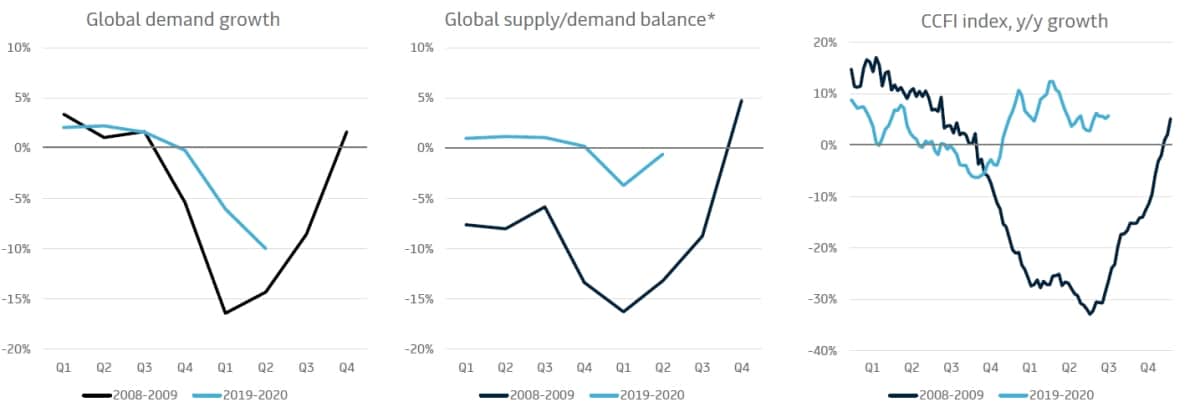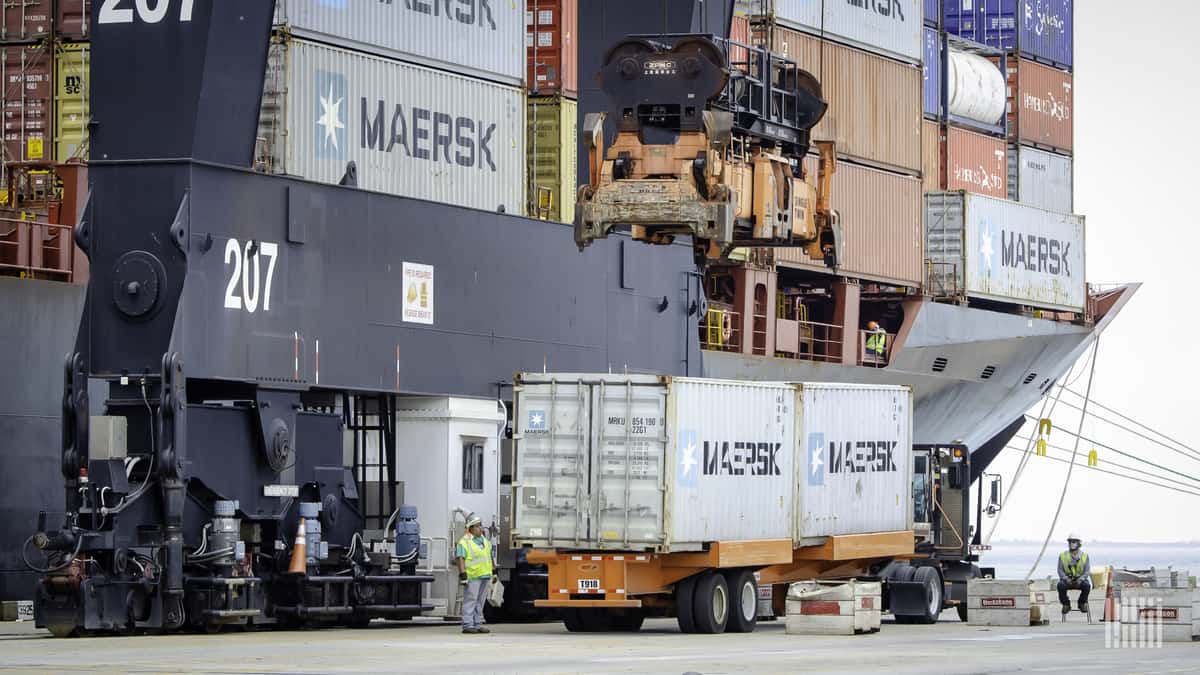The good news is that container shipping looks like it will weather the coronavirus crisis. The even better news is that COVID-19 has accelerated and solidified a new, more resilient business formula for the industry.
On Wednesday, the owner of the world’s largest container line, A.P. Moller-Maersk (APM, Copenhagen: MAERSK-B), posted stronger-than-expected results for the second quarter — the very quarter the coronavirus was peaking.
Maersk’s experiences during the outbreak confirm that liner alliances and consolidation are paying off, allowing capacity to be much more actively managed to match demand, supporting rates. The crisis has also confirmed the value of digital spot-booking platforms.
“Since it has worked so well for us [during the outbreak] why should we change that?” said APM CEO Soren Skou during the conference call, referring to active capacity management. “That will be our approach going forward. In my view, this is a structural change.”
Digital spot booking platforms will likewise be the new normal. “A version of a [digital] spot product will be ‘table stakes’ in two to three years.” Skou maintained.
The winning formula for container shipping that has emerged: consolidate capacity; toggle capacity in line with demand; go for profits not market share; split exposure between spot and period contracts; push spot customers toward digital booking platforms; and use spot booking data to more accurately toggle capacity in line with demand to further enhance earnings.
Strong quarterly results
APM reported net income of $443 million for the second quarter of 2020, almost triple net income of $153 million in Q2 2019. Earnings before interest, tax, depreciation and amortization (EBITDA) totaled $1.7 billion in Q2 2020, 8% above the consensus estimate of $1.58 billion. Projected full-year EBITDA is $6 billion-$7 billion, topping the consensus estimate of $5.8 billion.
In the ocean segment, Q2 2020 revenue was $6.57 billion, down 8.7% year-on-year due to a 15.8% volume decline offset by a 4.5% freight rate increase. Costs fell faster than revenues — down 16% to $5.16 billion due to lower bunker and time-charter costs. Consequently, Maersk’s Q2 2020 ocean EBITDA increased 26%, to $1.36 billion.

Three months ago, Maersk predicted second-quarter demand could fall by 20-25%. As it turned out, demand was down 20% in April, but by a lesser amount thereafter. Demand is down this month by the mid to high single digits, reported Skou.
Maersk “blanked” (canceled) more than 166 sailings in Q2 2020. “Tight capacity deployment led to a decrease in capacity that was slightly more than the decline in actual volume, as we expected the decline in volumes to be steeper,” acknowledged APM CFO Patrick Jany.
Carriers have added that capacity back. Skou said that as of now, Maersk has more capacity deployed in the trans-Pacific market than it did at this time last year.
Capacity reductions in Q2 2020 helped prop up rates. Rising rates in the spot market — which accounts for about half of Maersk’s business — brought up the overall average. Decreases in the Bunker Adjustment Factor (BAF) due to declining fuel costs have brought contract rates lower. Some contracts adjust BAFs monthly, some quarterly.
Active capacity management
When the coronavirus struck, the initial reaction among analysts and executives was to compare potential outcomes to the aftermath of the global financial crisis. But container lines are behaving much differently now than they did then.
According to Skou, “In 2009, the thinking at Maersk, and I think of the whole industry, was that if you had a network you would have to keep sailing it and filling it up at all costs. We lowered prices in order to fill the network. Obviously, that approach has now completely changed.
“In 2009, we went after market share. This time, we are focusing on profitability. We have been saying that for a couple of years and the pandemic has just strengthened our resolve.
“It’s not just because of the [change in] culture and the way of thinking. We now have a much bigger network, which makes it much simpler to take out capacity. If you’re operating two weekly services from Asia to Europe, it’s a huge decision to take out one string, because you cannot cover all the ports and some customers will not be served. If you’re operating 13 or 14 strings, as we were before the crisis, it’s quite a simple proposition to take out capacity and still serve all customers,” said Skou.
“The other big difference today is that in 2009, the industry, and for that matter ourselves, had an orderbook equal to 50-60% of existing capacity. Today, the orderbook is around 9%,” he added.

Digital spot-booking platforms
The other big structural change is the move to online spot bookings via platforms such as Maersk Spot. According to Jany, Maersk Spot has gained further traction and accounted for over 40% of the company’s Q2 2020 spot volumes.
“We see plenty of potential for expansion and eventually it will be close to 100%,” said Skou. “The complication right now is how to implement it in the U.S., where there are rules to file with the Federal Maritime Commission that we need to resolve.
“The big benefit for us is that it’s a commitment product. That means the customer makes a booking and actually has to show up with a container or pay a penalty. That, of course, makes it easier for us to plan utilization. We can avoid situations where we risk ‘rolling’ [pushing back loadings of] our customers when we get it wrong.
“There’s also a cost benefit to us because the customer is doing all the work in terms of getting a price online, making a booking and doing the documentation,” said Skou, who added, “Frankly, I think it would be very strange if our industry did not develop in this [digitalization direction], just like we have already in business-to-consumer industries.”
The coronavirus appears to be speeding up the transition. Sea-Intelligence CEO Lars Jensen commented on Wednesday, “The digital change in the industry has been massively accelerated and anyone not ‘on the train’ at this point needs to play catch-up real quick.” Click for more FreightWaves/American Shipper articles by Greg Miller
MORE ON CORONAVIRUS AND CONTAINER SHIPPING: Q&A with BIMCO’s Peter Sand on what’s next for the global supply chain: see story here. Trans-Pacific ‘going crazy’ as demand defies pessimists: see story here. Are trans-Pacific carriers guilty of price gouging? See story here.









Albert Ferguson
“Maersk profits validate the new container-shipping formula”, which is the same ol’Greco-Roman formula, MONOPOLY!
Albert Ferguson
“Maersk profits validate the new container-shipping formula”, which is the same ol’ Greco-Roman formula, MONOPOLY!